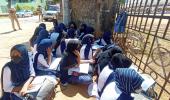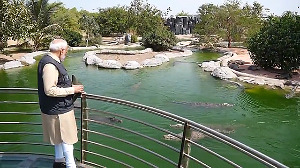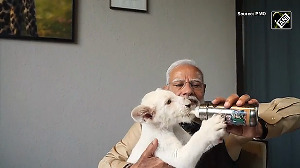The Karnataka high court on Friday said it has called for a report from the state government on the role of radical organisations behind the hijab controversy in the state. The Karnataka high court on Friday said it has called for a report from the state government on the role of radical organisations behind the hijab controversy in the state.

The court was hearing a petition filed by Ghanshyam Upadhyay who sought an investigation by the Central Bureau of Investigation and the National Investigation Agency into the row that started from the coastal district headquarters town of Udupi and spread to different parts of Karnataka last month.
"We have already called for a report from the government and we will consider your submission," Chief Justice Ritu Raj Awasthi told senior advocate Subhash Jha from Mumbai, who represented Upadhyay.
The full bench of the high court comprising CJ Awasthi, Justice J M Khazi and Justice Krishna S Dixit has been hearing the case on a day-to-day basis since February 10.
Presenting his argument before the bench, Jha said the agitation pushing for wearing of hijab in class-rooms was the handiwork of radical organisations, which are funded by some foreign nations.
"An agitation of this magnitude cannot be created overnight and therefore if this agitation is engineered and this is obviously engineered, funded by some organisation, this cannot start out of the blue. This is the sinister design," Jha told the bench.
The Karnataka high court on Friday said it has called for a report from the state government on the role of radical organisations behind the hijab controversy in the state. The chief justice sought to know whether he has presented any material to show that there is some organisation and people behind this agitation.
To this, Jha said when the court was hearing the batch of petitions, Harsha, a Bajrang Dal activist, was killed in Shivamogga and a radical organisation's name has surfaced.
In reply, CJ Awasthi said it was not proper to draw any conclusion when the investigation was pending and the police were doing their work.
"Unless the police comes out with something related to this case saying that it was this organisation which is linked to the killing of that person, we cannot draw presumptions," the chief justice said.
The counsel said receipt of information and not the credible information is sufficient to start an investigation.
"All these abundant circumstances sufficiently indicate that there is something much more than what meets the naked eyes," the lawyer argued.
Asking Jha to refrain from drawing presumption, the chief justice said the authorities have been taking appropriate action wherever there is a problem.
"We cannot draw presumption that the case requires to be handed over to the CBI or NIA for investigation," Justice Awasthi said.
Jha urged the court to consider calling upon Union home ministry, which is a party.
"Let there be a report by the home ministry to tell the court that there is some sinister design like this," Jha contended.
Highlighting that such petitions are being filed at a regular intervals in various courts, he wondered how many hours of judicial time were spent on these issues.
The Karnataka high court on Friday said it has called for a report from the state government on the role of radical organisations behind the hijab controversy in the state.
In his rejoinder argument, senior counsel Professor Ravi Varma Kumar, representing the petitioner Muslim girls arguing against the government's hijab ban, said the College Development Committee headed by the MLAs of the government colleges in their respective constituencies and their nominee members cannot be vested with administrative powers.
Citing a case, he said out of 12 members in the CDC, 11 are the nominees of the MLAs.
"An absolute power has been given to the MLAs. The college has been handed over to the MLA on a platter," Kumar contended.
He also pointed out that the elected representatives have the recommendatory role and not the administrative role.
"There is no accountability of the MLA who sits like a monarch in the college. Supposing there is financial irregularity and the committee is found involved in it, who will investigate them," Kumar said.
Senior advocate Yusuf Muchchala, quoting verses from the Quran, argued that the tradition of Islam enjoins covering head and neck.
The Karnataka high court has been hearing the matter related to hijab since February 8. For the first two days, the single judge bench of Justice Krishna S Dixit was hearing the matter.
However, on February 9, he referred the matter to the chief justice saying a larger bench could hear the matter.
Accordingly, CJ Awasthi formed the three-judge full bench and heard on a day-to-day basis in the last two weeks a batch of petitions filed by some Muslim girls seeking permission to wear hijab in educational institutions where a uniform has been prescribed.
The girls were allegedly denied entry to the Udupi Pre-University Girls' College in December last year for wearing hijab as it was against the prescribed uniform.
On January 1, six girl students of a college in Udupi attended a press conference held by the CFI in the coastal town protesting against the college authorities denying them entry into classrooms wearing hijab.
This was four days after they requested the principal permission to wear hijab in classes, which was not allowed. Till then, students used to wear the headscarf to the campus, but entered the classroom after removing it, college principal Rudre Gowda had said.
"The institution did not have any rule on hijab-wearing since no one used to wear it to the classroom in the last 35 years. The students who came with the demand had the backing of outside forces," Gowda had said.
As the issue of hijab versus saffron scarves spread to several educational institutions in many parts of Karnataka, the state government announced holiday from February 9 to February 15 in all the pre-university college and from February 9 to February 16 in degree and diploma colleges.
In its interim order, the bench asked the state government to reopen the educational institutions, which were hit by the agitation, and restrained students from wearing hijab and saffron scarves in the class-room till the final order is delivered.











 © 2025
© 2025